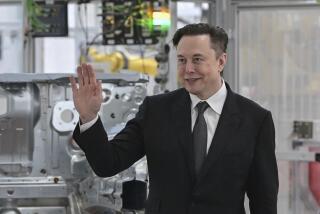No missing the impact of VW’s ad campaign
So these two guys on TV are rolling down the road, chatting about this and that and just generally chillin’ when out of the blue comes this red pickup. Car meets truck. Tires shriek, metal bends with a concussive thud, glass shatters and sprays. The two guys fly out of their seats like flour sacks, faces planted into the spreading white of the car’s airbags.
The violent crash isn’t part of a shoot’em-up film or a cop show. It’s one of two much-debated commercials from Volkswagen of America for its Jetta sedan.
The German automaker says it is selling the durability and safety of its product; the crashes are followed by shots of the passengers walking away, dazed but uninjured. Viewers, however, might be forgiven if the ads jolt them off the couch much like the two guys in the commercial.
Love ‘em or hate ‘em -- and VW says it’s gotten strong reactions both ways -- the Jetta commercials represent new territory in car advertising, a line crossed. After steering clear of safety pitches for decades, carmakers began to tout safety in earnest in the 1980s with the advent of family-friendly minivans and government crash test ratings, says Clarence Ditlow, executive director of the Washington-based Center for Auto Safety. The ads went from static comparisons to more explicit imagery in the 1990s, with driverless cars and crash test dummies slamming into walls in test labs.
But safety and advertising pros cannot remember any car company going so far as to show people being banged around in such shocking and violent circumstances as VW has. BMW even declined to air an ad five years ago because footage of a crash dummy being crunched was deemed “too scary,” says Claudia Caplan of Mendelsohn Zien Advertising in Santa Monica, which handled the campaign.
VW says its two commercials, created by the Miami agency Crispin Porter + Bogusky and themed “Safe Happens,” weren’t tricked up in any way. The crashes were shot in one take, using stunt people and real, non-reinforced Jettas, says Karen Marderosian, Volkswagen of America’s director of marketing. The company even conducted the crashes according to the speeds used by the National Highway Traffic Safety Administration (NHTSA) in its crash tests -- 32 mph in the head-on collision (shown in the spot featuring the two guys) and 18 mph in a side-impact crash (featured in an ad with two couples in a car).
Marderosian says she’s heard the complaints: about using “shock value” to sell, about the unpleasant reaction that accident victims might have upon suddenly encountering the commercials. But that misses the point, she says: “We’re trying to get people’s attention, yes, but not purely for shock value.” Instead, the ads are pegged to the Jetta’s four-star (frontal) and five-star (side) ratings in the NHTSA tests.
Safety experts generally applaud VW’s depictions, saying the company raises public awareness about auto safety with very memorable advertising. “If [the ads] make people aware of their vulnerability when they get into their vehicle, that’s a good thing,” says Adrian Lund, president of the Insurance Institute for Highway Safety, an industry-funded group. “It’s a whole lot better message than telling people the stereo has 400 watts.”
On the other hand, Judie Stone, president of Advocates for Highway and Auto Safety, a consumer and industry group, points out that your results in an auto accident may vary -- widely. “Nothing is foolproof in a crash,” she says. “I think the company knows that. By showing such a positive outcome -- when it might not be that way in the real world -- you wonder if they’re taking a risk of saying, ‘The car will take care of you.’ Chances are, the car will protect you. But you just don’t know.”
VW acknowledges that, in the fine print. Placed beneath the crumpled image of the cars, text reads, in part: “All crashes are different and severe injuries can occur. Airbags do not deploy in all accidents.”





